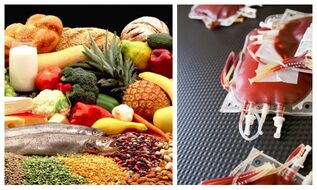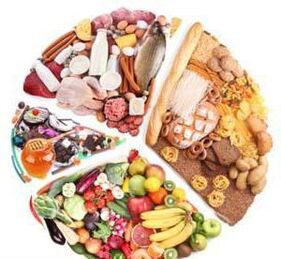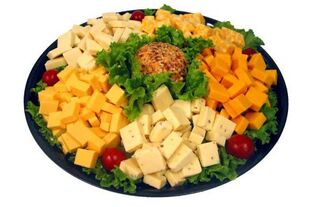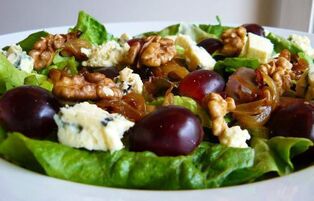Everyone starts to think about the correct eating habits, this has reached an age. Some people make this decision because of being overweight, while others are struggling with illness. One person lost his mind and re-read a lot of literature to find the right choice for a healthy diet. How to choose a diet to get the most benefit? A professional nutritionist can provide advice. After all, if there is a problem with changing diet, amateur performances can be expensive.
It should be understood that food can be cured and sometimes even paralyzed. Therefore, any diet should be based on the laws of nature and harmony. Only in this way can diet be beneficial.
Nature has created everything in amazing ways. There are 4 seasons, 4 growth stages, and 4 basis points. Surprisingly, there are also four blood types. Each of them has its own composition. Today, a special blood type diet has been developed, in which certain foods are selected for each food.
Basic diet
Based on many years of medical practice, Peter D'Adamo, an American doctor, has conducted many consultations on nutrition issues and supported his father’s research to show the world aThe unique nutritional method was later called "blood type diet". It is based on the assumption that weight, height and, of course, skin color are not the main differences between people. It all depends on blood type.

Lecithin, which can saturate all tissues of the human body, is consumed with food. These important cellular building blocks interact with blood types in completely different ways. In terms of chemical composition, meat lecithin is significantly different from plant foods. In order to have good health and longevity, those building substances should be consumed in food, which will bring more benefits to the body.
Menu selection based on common ancestor
The blood type diet is based on an evolutionary split developed by American immunochemist William Clouser Boyd (William Clouser Boyd). Based on this theory, owners of the same blood type have a common past. From a nutritional point of view, this allows you to get an exciting trip in time and benefit a lot from it.
- Blood type 1. According to the doctor, these are human hunters. He believes that such a group is the lineage of the earliest people on earth. Of course, the best nutrition is a high-meat diet.
- Group 2. This population ranks among farmers. The ideal diet for such people is predictable. It is recommended that they eat more vegetables and minimize red meat in their diet.
- Group 3. It defines the nomads. The owner of this blood is known for its strong immunity and low-key digestion. However, the third group of people should be very careful when using dairy products. After all, their lactose intolerance is a recognized fact in history.
- Group 4. These people are a unique mystery. Because this rare blood combines the characteristics of different groups, it has only recently appeared and illustrates the evolutionary variability.
Product table
For convenience, below is a table of the list of foods to be included in the menu. For example, it is known that if a person's blood type is 2, vegetables should be included in the diet. The diet (recommended food list) confirms this, although it may contain other ingredients.

Health Products
| The first group | The second group | The third group | Fourth group |
| Herbal soup of fish, meat, various seafood, fruits (except acids), vegetables, green tea, rye bread, rose hips, mint and ginger | Cheese (low-fat variety), dairy products, beans, soy milk, coffee, pineapple, juice, green tea and red wine | Meat (excluding chicken and duck), dairy products (non-fat), cereals (not buckwheat and wheat), eggs, fruits, vegetables, beans | Rabbit, turkey, lamb, fish, dairy products, olive oil, beans, nuts, grains, fruits (excluding acid), vegetables, green tea, coffee, herbal tea |
In addition to healthy food, the blood type diet also contains so-called neutral products. They are listed in the following table:
| The first group | The second group | The third group | Fourth group |
| Herbal tea of beer, raspberry, chamomile, sage, ginseng, valerian, wine (red and white) | Milk hard cheese (low fat), goat cheese, cheese | Soy products, orange juice, black tea, wine, beer, coffee | Herbal tea (raspberry, mint, valerian), beer, wine |
Harmful products are also highlighted in a separate table.
| 1 set | 2 groups | 3 groups |
| Chinese cabbage (except broccoli), pickles, mayonnaise, ketchup, corn flour (all made products), alcohol, tea with raspberry and aloe vera, coffee | Dairy products, meat, chili, wheat, sugar, ice cream, butter, herring, halibut, seafood, caviar, rhubarb, oranges, bananas, oranges, coconuts, soda, black tea | Fish, shrimp, shellfish, duck, chicken, pork, corn, lentils, olives, peanuts, tomato juice |
The particularity represented by the first group
Every "hunter" should understand their positive aspects. But you should not underestimate the risk factors. The diet in the blood type 1 diet requires high-protein foods, meat.
Generally, these people are strong, self-sufficient and purposeful.
Definitely:
- Excellent digestive tract;
- Excellent immunity;
All of these, the owners of the first group also have weaknesses. Knowing them is important enough. It is worth noting that the blood type 1 diet has fully considered all these characteristics.

is related to the following risks:
- Blood clotting problems;
- Prone to various inflammatory processes;
- Prone to ulcers due to high acidity;
- Allergies.
Therefore, you can take care of your health and choose the best product according to the group you belong to.
However, the problem of Rh factor often occurs. Studies have shown that it should not affect the diet formula. One blood type-negative and positive-means that the synthesis of nutrients is the same. This means that the diet is the same. Therefore, the diet menu varies according to blood type, but not at all according to Rh factor.
Approximate menu of 1 group
Day 1
Breakfast.Rye bread sandwiches with a little butter. A slice of goat cheese is also great. Brew herbal tea as a beverage.
Lunch.Sorrel broccoli chicken soup (about 250 grams). Make a liver salad (you can use chicken or beef), spinach and tomatoes. Season with soy sauce.
Snacks.Walnuts or almonds (50 grams). The fruit is perfect-bananas, apples, plums.
Dinner.Add oyster mushroom garnish (approximately 250 g) to the cooked beef. Brew tea with St. John's Wort and mint.
Day 2
Breakfast.Use soy milk to cook buckwheat porridge. Green tea will refresh you.
Lunch.Use cream, garlic and herbs to make seafood soup. Second, a salad of carrots, asparagus and herbs would be the ideal solution. Brew herbal tea as a beverage.
Snacks.Pine nuts, walnuts or almonds (50g) can be used. Allow you to choose 1 kiwi, pear or apple by yourself. Or 50 grams of prunes.
Dinner.Grilled chicken fillet with pineapple. Garnish with white peas or peppers. Today, you can drink cranberry juice.

Day 3
Breakfast.Refresh yourself with feta bread. Tomatoes will complement the menu. Green tea will give you strength.
Lunch.A delicious mushroom soup, slightly fried with vegetables for seasoning, is the right solution. Taste a salad of eggs, shrimp, cucumber and apple.
Snacks.50 grams of nuts, 1 fruit and 50 grams of plums.
Dinner.Bake fish (250-300 g) in the oven.
Characteristics of the second blood type
Farmers do not include meat and dairy products. The green light for vegetarianism. The diet is based on rich plant foods. Blood type 2-positive or negative, the same as the first blood type, requires absolutely the same nutrition. Therefore, any Rh factor owner can safely use the same scheme.
The characteristics of this group are stability, settlement, collectivism, and organization.
The specially developed diet takes into account all the characteristics of health and digestion. Blood type 2 (positive and negative) gives representatives the following advantages:
- The efficiency of the digestive system and immune system (only when following vegetarianism);
- A high degree of adaptation to the diet itself and the environment.
Unfortunately, the second group also gives the owner weaknesses.
Including:
- High threshold of nervous system excitability;
- Increased the sensitivity of the digestive tract;
- Immunity applies to all infections.
Recommended menu for blood type 2
Day 1
Breakfast.Prepare rice porridge with almonds (250g) in the morning and wash it with green tea.
Lunch.Cooking vegetable cream soup. For this, use carrots, Brussels sprouts, potatoes, and pine nuts. A serving of about 250 grams, enjoy a salad of tomatoes, cucumbers and radishes. Season with olive oil. Salads can be prepared in slightly different ways. The most important thing is not to forget: if you have a second blood type, your diet should be vegetarian.

snacks.Cashews or Brazil nuts (50g) will completely satisfy your hunger. Of course, there is another vegetable to choose from-tomato or cucumber. Can be replaced by fruits-apricots or plums (1-5).
Dinner.Stewed mushrooms with carrots and zucchini (250g). Wash with pineapple juice.
Day 2
Breakfast.Buckwheat porridge will be a hearty breakfast. It should be cooked with soy milk. Wash breakfast with green tea.
Lunch.Sorrel egg soup can enhance physical strength. The recipe includes carrot, asparagus and herb salad. Cherry juice will significantly improve breath.
Snacks.Pine or walnuts, almonds (50g) will help you replenish energy. From fruits-apricots or plums. We recommend plums or dried apricots (50 g).
Dinner.Cook turkey fillet at night. Let rice and vegetables become side dishes. Supplement vitamins from cranberry juice.
Day 3
Breakfast.In the morning, please eat your own vegetable or fruit salad. And you can drink coffee.
Lunch.Prepare mushroom soup with vegetables. You will appreciate the salad made of cheese, cucumber, egg and apple.
Snacks.Nuts and fruits will help relieve hunger.
Dinner.Bake fish with cooked mung beans (250-300 grams).
The peculiarities of the 3 blood type owners
These people are very comfortable. The diet of the third blood type is varied. People are known for flexibility, balance and creativity.
represents an advantage:
- High adaptability to diet and environment;
- Stable immunity;
- Sclerosis of the nervous system.
As for the weaknesses, there are almost none. Nutritional imbalance can cause trouble. This leads to autoimmune diseases.
Remember, Rh factor does not affect your diet. The three blood types-negative and positive-require the same nutrition. Therefore, you can rest assured of dietary recommendations.
Menu of 3 blood types
These people are lucky to have a mixed diet. The blood type 3 diet provides great opportunities for food choices.

Day 1
Breakfast.Use apples to cook rice porridge (250g). Make yourself an herbal tea made from St. John's Wort or mint.
Lunch.Boiled carrot, potato and mushroom cream soup (250g). You can afford a salad of sardines, eggs and cheese. Season with low-fat yogurt or olive oil.
Snacks.Let you feel cashews, nuts (Brazil or walnut) better. One serving-about 50 grams, 1 cucumber or 1 carrot as a snack. And choose any fruit (1-3 pieces).
Dinner.Boil the beef with eggplant and pepper (250g).
Day 2
Breakfast.Cook oatmeal (250g) in the morning.
Lunch.Make a cream soup with broccoli (Brussels sprouts) and broccoli. You can afford any fruit salad.
Dinner:Stewed hare in the evening. Rice with vegetables will be a good side dish. Wash with green tea.
Day 3
Breakfast.Low-fat yogurt will give you morning strength. Make sure to add 1 apple to the diet. Drink berry juice.
Lunch.Make mushroom soup. Season with vegetables. Of course-salad. Made with beef, Chinese cabbage, cucumber and coriander.
Snacks.Eat nuts or fruits in the afternoon.
Dinner:Grilled fish and green beans (250-300 grams).
The characteristics of the fourth blood type
From a historical perspective, it is a relatively new form and has a mysterious status. It is recommended for people with 4 positive blood types, with a moderate diet, but at the same time a mixed diet.
The strengths of these people include:
- flexibility of the immune and nervous system;
- A combination of 2 and 3 blood type advantages.
Weaknesses:
- Tenderness of the digestive tract;
- The immune system is exposed to infection.
Approximate menu for group 4
Day 1
Breakfast.Made oatmeal (250g) with apricots and apples. Coffee will cheer up.

Lunch.Boil vegetable cream soup (250g). Salads can be made with eggs, cheese, and sardines. Season with sour cream or olive oil.
Snacks.Almonds or nuts (50g) will completely satisfy your hunger. For vegetables, you can eat 1 carrot or 1 cucumber. Choose the fruit that suits your taste (1-3 pieces).
Dinner.Boil lamb, add pepper and eggplant (250g).
Day 2
Breakfast.Cook some porridge (250g) for yourself.
Lunch.The cream soup made with different types of cabbage is perfect. Any fruit salad.
Snacks.Nuts (50g), dried apricots or plums (50g) and rye crackers (1-2 pieces) will be an excellent afternoon snack.
Dinner.Addicted to seafood shreds.
Day 3
Breakfast.Eat low-fat yogurt and 1 pear. You can wash it with sea buckthorn juice.
Lunch.A high-quality soup with vegetables and salad (Chinese cabbage, tomato, turkey and cheese) will provide you with perfect support.
Snacks.The afternoon snack can include fruits and nuts. You can drink kefir.
Dinner.Grilled fish and rice (250-300g).
Conclusion
The blood type diet is a systemic diet plan. It requires a thorough modification of the diet, and there is no guarantee that a high level of diet will be obtained at a specific time. However, according to the opinions of the developers, the coincidence of diet and blood requirements can completely get rid of excess weight. However, this process only begins when the metabolic process in the body is regulated. Its authors recommend their own diet to those who want to gradually lose weight by cleaning all systems. Or those who decide to seriously engage in disease prevention, these diseases also have their own specificities and belong to blood types.































